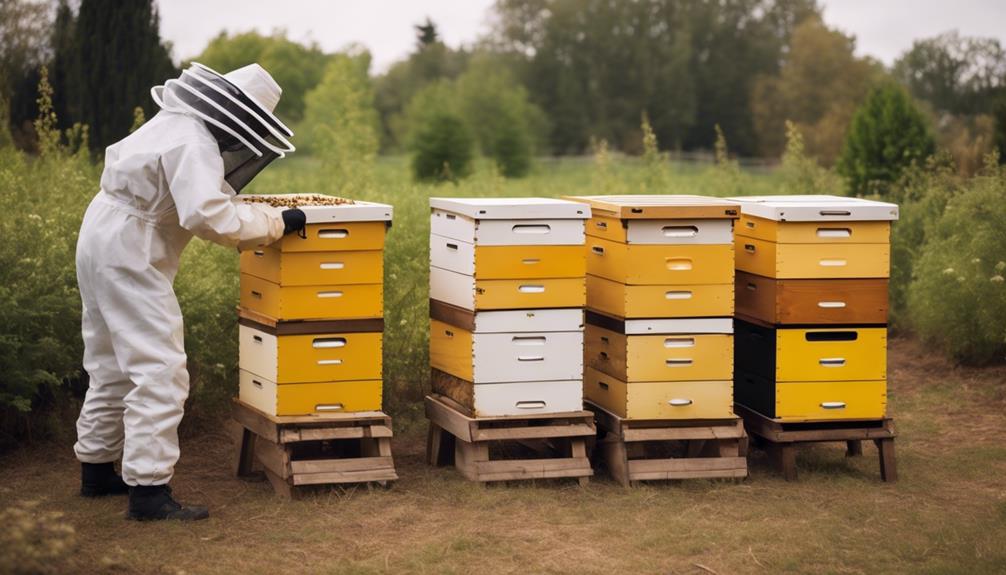In terms of how much honey a Flow Hive can make per year, it’s all about optimizing the conditions for our buzzing friends. Factors like local flora for nectar, hive health, sunny days, and enough storage space deeply impact honey yield. On average, a Flow Hive can produce between 30 to 100 pounds of honey annually, influenced by factors like bee population, hive health, and regional differences. Ensuring a robust bee population, proper hive management, and favorable environmental conditions are essential for peak production.
And remember, the proximity of nectar-rich flowers, weather conditions, and colony health all play key roles in honey output. Uncover more about boosting your honey harvest potential by considering these factors.
Main Points
- Annual honey yield ranges from 30 to 100 pounds.
- Local forage availability and hive health are crucial factors.
- Regional differences impact honey harvest averages.
- Colony buildup, bee management, and environment affect yield.
- Proper care and monitoring optimize honey production.
Factors Affecting Flow Hive Honey Production
When aiming to understand the honey production potential of a Flow Hive, one must consider various factors that significantly impact the yield. Bees play an essential role in honey production within the hive, tirelessly collecting nectar from the local flora. The health of the hive is important, as a strong bee population leads to higher honey yields.
Weather conditions also come into play; bees are more productive on sunny days. Ensuring there’s ample space for honey storage within the Flow Hive is crucial; it directly impacts the amount of honey that can be harvested. Additionally, regular monitoring and maintenance routines are key to maximizing honey production.
Importance of Favorable Conditions for Yield
In terms of honey production in a Flow Hive, the conditions play a vital role. Factors like climate, bee population, and hive location significantly impact the amount of honey you can harvest each year.
Ensuring that these elements align can make a substantial difference in the yield you get from your Flow Hive.
Climate Affects Honey Yield
In achieving the best honey yield from Flow Hives, the climate plays a pivotal role by influencing the abundance of honey-producing flowers and supporting bee activity through adequate sunlight and warmth. Bees thrive when the conditions are just right – not too cold, not too hot – just like Goldilocks’ perfect porridge.
The dance of the bees, buzzing from flower to flower, is like a symphony orchestrated by the sun and the gentle warmth, creating the sweet nectar we all love. Imagine a world where every day is a sunny day, and the bees are humming with joy, crafting honey with unmatched flavor. That’s the kind of climate that sets the stage for a bountiful honey yield from your Flow Hive.
Bee Population Influences Production
Maintaining a robust bee population in a Flow Hive significantly boosts annual honey production. The more bees buzzing around, the more nectar they can collect and turn into that sweet golden honey.
With a thriving bee population, there are plenty of foragers keen to gather nectar, leading to efficient honey-making processes within the hive. It’s like having a bustling team of honey creators working tirelessly to maximize those honey yields.
Hive Location Impacts Harvest
The hive’s location significantly influences the honey harvest in a Flow Hive due to the impact of varying environmental conditions. When selecting a spot for your Flow Hive, consider the availability of abundant honey-producing flowers and warm weather, as these favorable conditions can boost honey yield.
A Flow Hive typically produces between 30-100lb of honey per year, with southern regions often yielding higher amounts due to longer daylight hours and consistent weather. Ideal conditions in the right location can maximize the honey production potential of your hive.
Average Annual Honey Yield Range
Regarding the average annual honey yield range of a Flow Hive, beekeepers can expect anywhere from 30 to 100 pounds of honey per year. Factors like local forage availability and hive health play a significant role in determining the final production.
Additionally, regional differences can lead to variations in the amount of honey harvested, making it essential to monitor hive progress and environmental conditions closely.
Yield Range Overview
On average, a Flow Hive can yield anywhere between 20 to 70 pounds of honey per year. Here’s a breakdown of why the annual honey yield range can vary:
- Colony Buildup: Bees need time to gather nectar and build up their honey stores before you can harvest.
- Bee Management: Proper care and attention to your bees’ needs are vital for maintaining a healthy and productive hive.
- Environmental Factors: The local environment plays a significant role in honey production, affecting the availability of nectar sources.
- Bee Behavior: Understanding your bees’ behavior is key to maximizing honey production. By observing and adapting to their habits, you can help them thrive and produce more honey.
Factors Affecting Production
Factors impacting honey production in a Flow Hive range from colony buildup to bee management practices and environmental conditions. Essential care plays a crucial role in ensuring a healthy hive and maximizing honey production.
Understanding the needs of the bees is key; neglect can lead to hive failure or decreased honey yield. Bees require time to build up stores before you can extract honey from a Flow Hive. By observing bee behavior closely, beekeepers can make informed decisions to support the colony.
Whether it’s optimizing the hive setup or ensuring a suitable environment, each factor contributes to the overall honey production. By prioritizing colony buildup, implementing effective bee management practices, and considering environmental conditions, beekeepers can work towards a successful harvest.
Regional Variances
Considering the regional variances in honey production, Flow Hives can generate an average annual yield ranging from 20 to 70 pounds.
- Local flora plays a significant role in determining the honey output of a Flow Hive.
- Weather conditions, such as temperature and rainfall, directly impact the annual yield.
- Hive health is essential; a strong and disease-free colony is more likely to produce higher amounts of honey.
- Proper bee management practices, like regular inspections and timely interventions, can optimize honey production.
Regional differences in environmental factors mean that not all Flow Hives will yield the same amount of honey. Understanding these variations and adapting beekeeping practices accordingly can help beekeepers make the most of their Flow Hive’s potential in any location.
Peak Production Potential of a Hive
How can a well-maintained Flow Hive achieve its peak honey production potential in a year?
Peak honey production in a Flow Hive hinges on several key factors. Ensuring hive health through regular inspections and maintenance is crucial. A robust bee population and favorable environmental conditions play significant roles in maximizing honey production. Diligent management practices and proper care can optimize the hive’s performance.
Impact of Honey-Producing Flowers Availability

The proximity of honey-producing flowers to a Flow Hive significantly influences its annual honey production. Here are some key points to take into account regarding the impact of honey-producing flowers availability on honey yield:
- A rich variety of nectar-rich flowers near the hive is essential for maximizing honey production.
- Flow Hives benefit greatly from high concentrations of honey-producing flowers in the vicinity, leading to increased honey yield.
- Above-average rainfall in the previous rainy season can boost nectar secretion in honey-producing flowers, further enhancing honey production levels.
- Flow Hives surrounded by abundant honey-producing flowers have a higher potential for reaching peak honey production levels, showcasing the importance of the environment on honey production.
Role of Weather Conditions in Honey Yield
Weather conditions play a pivotal role in determining the yield of honey from a Flow Hive. The amount of nectar richness in flowers is directly impacted by the weather, affecting honey yield.
Bee foraging behavior is influenced by the duration of daylight, which ultimately plays a significant role in honey production. Additionally, the availability of hive space for surplus honey storage is greatly affected by weather conditions.
Healthy hive populations, which are influenced by various weather factors, are essential for ideal honey production. Factors like nectar secretion in flowers, influenced by weather conditions, directly impact the amount of honey that can be harvested from a Flow Hive.
Understanding and adapting to these weather conditions can help maximize honey yield from your hive.
Influence of Bee Colony Health and Size

Maintaining a healthy bee colony is essential for maximizing honey production in a Flow Hive. Here are some key factors that influence bee colony health and size, ultimately impacting annual honey yield:
- Bee Population: The size of the bee population within the hive directly correlates with the amount of honey produced each year.
- Bee Management: Proper bee management practices, including disease prevention and mite control, are vital for enhancing honey production.
- Environmental Factors: Elements like flower abundance and weather conditions play a significant role in determining the annual honey output of a Flow Hive.
- Colony Health: Optimal bee health and colony buildup are critical for maximizing honey yield, highlighting the importance of proactive bee care to guarantee a productive hive.
Aligning Variables for Optimal Honey Output
To achieve peak honey output from a Flow Hive, it’s vital to carefully align key variables such as bee population, hive management, and environmental conditions.
The sweet spot for maximizing honey production lies in maintaining a robust bee population within the hive. Regular care and maintenance of the Flow Hive play a pivotal role in ensuring ideal conditions for honey production.
Keeping an eye on the local flora abundance can also significantly impact the honey yield. By monitoring environmental conditions and understanding bee behavior patterns, we can fine-tune our approach to honey production.
When these factors harmonize, the result is a bountiful harvest of honey dripping with the essence of the surrounding landscape.
Interplay of Factors in Honey Production

Considering the intricate dance between colony buildup, bee management practices, and environmental conditions, honey production in a Flow Hive is a dynamic process with yields typically ranging from 20 to 70 pounds per year.
Here are four key factors that influence honey production in a Flow Hive:
- Colony Buildup: Bees need time to establish their colony and store honey before peak production can be achieved.
- Bee Management: Proper care and understanding of bee behavior are essential for maximizing honey output.
- Environmental Conditions: Factors like weather and available forage play a significant role in honey production.
- Hive Health: Neglecting the hive can lead to failure or reduced honey yields, emphasizing the importance of attentive beekeeping practices.

Roger Thomas is a seasoned beekeeper and hive architect with a deep-seated passion for sustainable living. His fascination with bees has shaped his professional career, giving him practical and theoretical expertise in bee behavior, colony health, and optimal hive conditions. Roger’s technical skills shine in his bespoke hive creations that cater to the specific needs of diverse bee species, while his sustainable practices promote environmental balance and the wellbeing of the bee population.
As he continues his journey in beekeeping, Roger has become a dedicated advocate for responsible practices and an insightful educator in his field. His posts aim to inspire new beekeepers, underline the importance of sustainability, and showcase the remarkable contribution bees make to our ecosystem. Roger invites you to join him as he delves into the world of bees and the rewarding, honey-sweet art of beekeeping.


